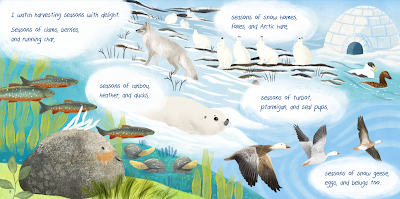Illustrated by Veselina Tomova
Running the Goat, Books & Broadsides
978-1-998802081
40 pp.
Ages 4-8
March 2024
In a tale from a Newfoundland outport, Bonnie Johnstone tells a story of a pig, a dumpling, and mayhem. It's a story that could only come from a small rural community in which everyone knows everyone else, and their actions are noted and intertwined for good and with misfortune.
After three fishermen tend to the garden belonging to the local convent, they are compensated with a hearty meal of stew with dumplings. As one of the men was not fond of dumplings, he tossed it towards the pig pen of Ignatius, Tulip, and their piglets. To his delight, Ignatius grabs that dumpling. To his horror, it scalds his throat and lodges there.
The scalding hot lumpof gluey doughplopped downinto his throatlikea corkinabottle.
In desperation, Ignatius makes a mad dash to the ocean, the ocean with icy cold water that would be sure to soothe his burning throat. But there is much activity in the outport, and it seems everyone is out and about and unknowingly in Ignatius's path. There's Tommy and Gussie who've gotten their kite stuck in Father McGettigan's rose bush. Then there's Father McGettigan and Reeni Puddicombe delivering pies for the church supper. Of course, Ignatius runs through and into Lizzie Carey's laundry hanging on the line, and, though he was able to miss the elderly Mrs. Maddigan and her cow Maude, the peddler Nellis was not as lucky.
 |
| From The Pig and the Dumpling, written by Bonnie Johnstone, illustrated by Veselina Tomova |
Perhaps The Pig and the Dumpling is a cautionary tale about gluttony or perhaps about chewing one's food, but maybe it's just a story about a community in which everyone is an important part, from a pig at a convent's farm to the kelp farmers, children, the elderly, and everyone in between. It's a community of life and living, in which neighbours help each other, in which fish is dried and kelp is collected, and laundry is hung out to dry, and pies are made for a church supper. That little dumpling may have stoppered poor Ignatius's throat temporarily, but it gave him the opportunity to get out and interact with others in the community. His interactions may have been problematic for many, including poor Ignatius, but Bonnie Johnstone gives us a happy ending and a glimpse into a rural Newfoundland community as it may have been in the 1800s. (Bonnie Johnstone's "A Note About the Story" gives a little more background.)
 |
| From The Pig and the Dumpling, written by Bonnie Johnstone, illustrated by Veselina Tomova |









































